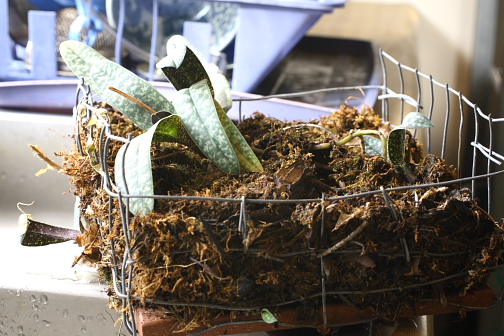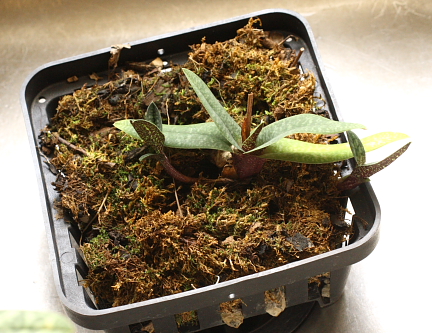I read some of the posts that described and pictured some armeniacums and maybe some micranthums in baskets with live sphagnum, and I decided to try an experiment. one other post or article I read talked about someone who had placed chunks of limestone I think in the bottom of a wire basket, then some other material along with chopped leaf material and then topped with live sphagnum. I had been at a binghamton, ny orchid society meeting where the speaker was talking about using sheet moss from downed trees and rocks out in the forest and was growing masdies and such on rocks covered with live sheet moss and placing in some shallow water. I figured I could make up something pretty close to what was described in the article.
I have some 4" or so square clay unglazed quarry tiles that I use to line my oven for making pizza and other things, put one of them in the bottom of a square basket I'd made from mesh fencing wire. On top I put some small chunks of granite from ditches near the adirondack park border (can't take anything out of the park....), put a bunch of mesic forest leaves that I chopped up with some scissors and topped with some sheet moss. all the leaves and moss came from my Uncle's farm (after scraping away the snow covering the stuff...).
I've only used seaweed fertilizer and humic acid additives from organic farming stores, and the plants have responded! (one other plant I put in a smaller plastic mesh container with a larger chunk of flat rock in the bottom) I had noticed a small growth out of the main growth in the bigger pot then a new one on the top of the media, then last week noticed two shoots out of the side of the 'pot'. the smaller container there are two shoots coming directly from the side of the flowering growth. in the past, I would have problems with new armeniacum growths turning black a little while after they had emerged from the top of the media. I was worried that both of these plants would eventually die if no new growths survived so felt I had to try something different. both need some new chopped leaves and a better covering of sheet moss (found a huge supply very close to here in the wet along the old erie canal trail on old, fallen trees *also where tasty shelf mushrooms pop out on the fallen trees...) but I have plenty of that.
they may not look overly great, but new growth is a heck of a lot better than black ones!

plant that flowered and posted here last winter/spring from main street orchids

plant from jim rice orchids that also flowered same time as above
I did the same thing with a paph micranthum that was placed in a different, warmer growing area, but I haven't kept it as moist as the armeniacums and I need to change the media or add more to let it to hold moisture a little longer. it hasn't really moved since the change, and looks a little dry
I have some 4" or so square clay unglazed quarry tiles that I use to line my oven for making pizza and other things, put one of them in the bottom of a square basket I'd made from mesh fencing wire. On top I put some small chunks of granite from ditches near the adirondack park border (can't take anything out of the park....), put a bunch of mesic forest leaves that I chopped up with some scissors and topped with some sheet moss. all the leaves and moss came from my Uncle's farm (after scraping away the snow covering the stuff...).
I've only used seaweed fertilizer and humic acid additives from organic farming stores, and the plants have responded! (one other plant I put in a smaller plastic mesh container with a larger chunk of flat rock in the bottom) I had noticed a small growth out of the main growth in the bigger pot then a new one on the top of the media, then last week noticed two shoots out of the side of the 'pot'. the smaller container there are two shoots coming directly from the side of the flowering growth. in the past, I would have problems with new armeniacum growths turning black a little while after they had emerged from the top of the media. I was worried that both of these plants would eventually die if no new growths survived so felt I had to try something different. both need some new chopped leaves and a better covering of sheet moss (found a huge supply very close to here in the wet along the old erie canal trail on old, fallen trees *also where tasty shelf mushrooms pop out on the fallen trees...) but I have plenty of that.
they may not look overly great, but new growth is a heck of a lot better than black ones!

plant that flowered and posted here last winter/spring from main street orchids

plant from jim rice orchids that also flowered same time as above
I did the same thing with a paph micranthum that was placed in a different, warmer growing area, but I haven't kept it as moist as the armeniacums and I need to change the media or add more to let it to hold moisture a little longer. it hasn't really moved since the change, and looks a little dry



